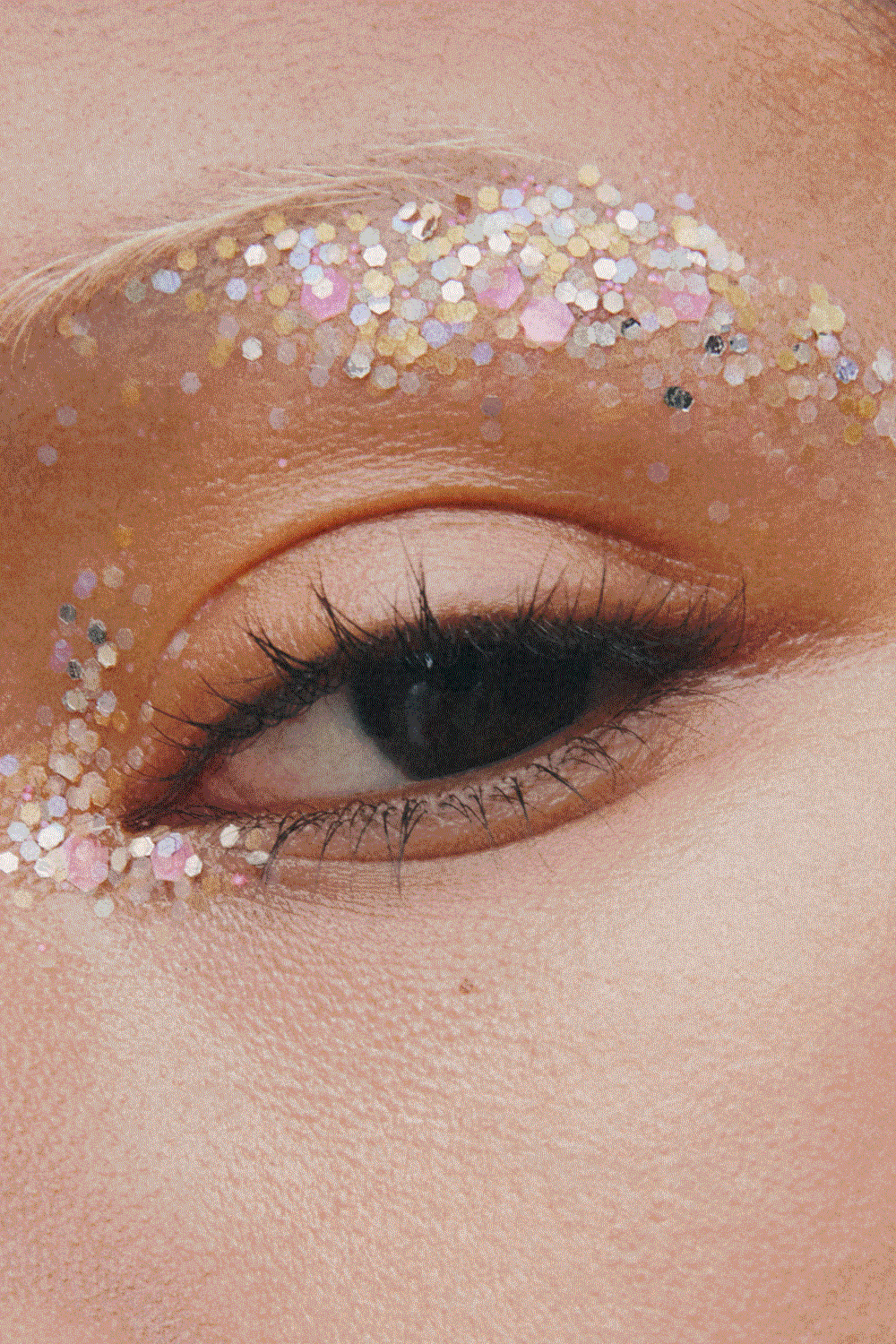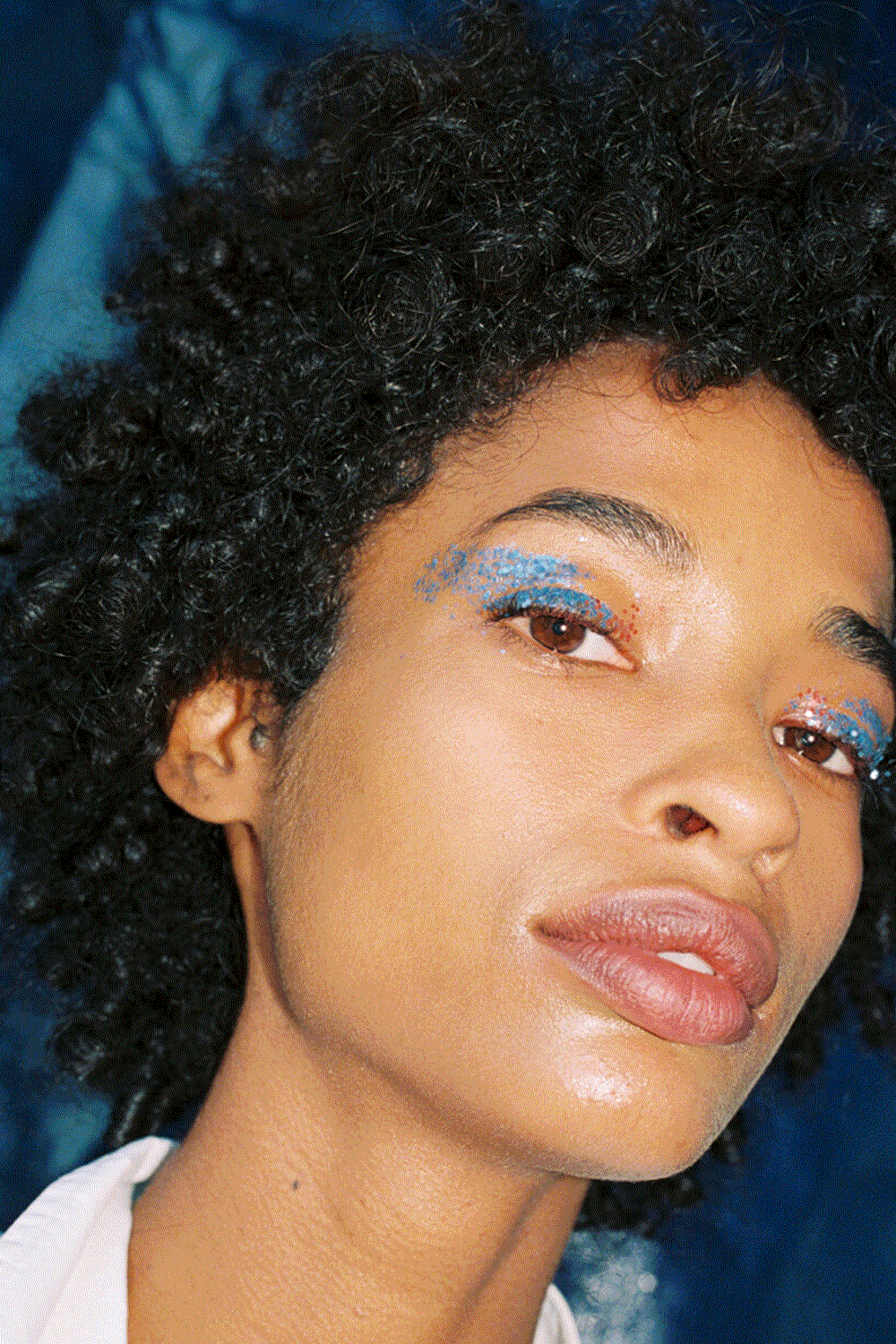Ganni, the Danish label known for its focus on sustainable innovation, is dipping a toe into beauty for the first time through a collaboration with Submission, the Los Angeles-based upstart that made its name on zero-plastic beauty.
Together, the two brands are launching a limited capsule of glitter ($25), made from a natural and plant-derived material and available in three colours: pink, gold and silver. The range will be saold on Ganni’s e-commerce site and its stores worldwide as well as Submission’s website.
It’s not the first time the two brands have worked together. Ganni used Submission’s products for both its Spring/Summer 2022 and Autumn/Winter 2022 shows at Copenhagen Fashion Week. The brands also tested a “soft” collaboration for the 2021 holiday season; customers who shopped at Ganni during this period received a sample from Submission. But the product collaboration, a first for both companies, is significant. For Ganni, it’s an opportunity to test the beauty market before potentially delving in further, while Submission gains a larger platform in an industry that still largely relies on harmful plastics.
Ganni’s creative director Ditte Reffstrup and Submission’s founder and creative director Zenia Jaeger have a decades-long friendship. Both of Danish origin, they crossed paths in their twenties while living in Copenhagen. It was Submission’s sustainability credentials that convinced Ganni to partner with the brand. Ganni was primarily responsible for branding and marketing while Submission oversaw sourcing and manufacturing. “I have massive respect for the work they have done to create a completely plastic-free product that is full of fun and shine,” says Reffstrup.
Carbon and plastic reduction are core focuses for Ganni, which has been a signatory of the New Plastics Economy Global Commitment launched by the Ellen MacArthur Foundation since 2019, according to Reffstrup. The brand is focused on finding alternatives to its poly bag by 2023. The collaboration with Submission provides Ganni with an opportunity to learn, she explains. “Beauty is a really interesting category with a lot of potential. We like to test small, and with this collaboration we are aiming to learn and get feedback from our community.”
Making zero-plastic appealing
Submission launched in 2020 as an editorial platform, open to anyone to submit their beauty looks, creative work, opinions or professional advice. The only requirement was that the submission had to be created responsibly. That means no synthetics, no plastic and no fast fashion in any visual imagery. “We’re very strict with that,” says Jaeger. A year on, she felt that industry progression was slow and eco-conscious brands were not marketed in an inclusive way. Their products, she observed, were targeted exclusively at a “white, very privileged or upper class” customer and were often “brown and came in a jam jar”.
Jaeger was also shocked by the Food and Drug Administration (FDA)’s light regulations when she moved from Denmark to the US in 2011. Today, the FDA has only banned 11 harmful substances in cosmetics products. In comparison, the European Union has banned around 2,000 hazardous chemicals over the last 13 years, and looking at the new current roadmap, estimates suggest this could include an additional 7,000 more substances by 2030.
And, while the EU market has shifted away from plastic, the material is still heavily dominant in the US. It was near-impossible to find zero-plastic beauty products in the US, Jaeger says. “There has been a wave of brands selling themselves on being cruelty free and vegan, but that doesn’t mean anything if their products come inside a plastic bottle.”
Submission began making products to set an example for other brands, starting with glitter. The decision wasn’t commercially driven, says Jaeger. While the brand could have potentially sold more if it had launched with an everyday product, it might not have been able to “tell the story about our mission and what we stood for”. Glitter, she explains, is often made of “cheap-looking” aluminium or plastic. Submission’s products use natural cellulose taken from wood pulp, primarily from eucalyptus trees, and are biodegradable (the level of biodegradability is certified by TÜV Austria, an independent body). “We wanted to show that you could be 100 per cent plastic free and still be colourful, fun and appealing.”
Launching with glitter helped to “put the brand on the map”, Jaeger believes. Other fashion brands, including Private Policy and Nyguen Inc, wouldn’t have used its products in its runway shows otherwise, she says. “It was great from a marketing perspective.” In 2022, Submission launched its second product — a balm — which is more for everyday use. In 2023, the brand will potentially introduce more mainstream beauty categories, such as highlighters, bronzers and body oils. Much is dependent on developing the right packaging, says Jaeger. “The world doesn’t need more makeup. We won’t launch a product if we can’t make a non-plastic container.” Submission’s containers are made of glass while the cap is made of tin, without the industry-standard polyethylene (PE) plastic liner.
Ganni and Submission plan to invest in a range of marketing activities such as promoting the collaboration through Instagram, but the most important channel will be physical events with its communities, both creative directors say. Expect “events where our community can get up close and personal with the products and also product gifting,” says Ganni’s Reffstrup. “It’s so important for people to feel and touch the products, to understand how amazing they are.”
Going plastic free
The personal care and beauty industry produces more than 120 billion units of packaging every year globally — most of which is not truly recyclable, according to the British Beauty Council, and ends up in landfills or oceans. In 2018, in the US alone, almost 7.9 billion units of rigid plastic were created just for beauty and personal care products. A 2020 report by Greenpeace found that only two of the seven standard classifications for plastics could legally be claimed to be recyclable in the US. A 2022 study that tested more than 7,000 products from leading beauty brands found that 87 per cent contained microplastics.
Another barrier is cost of production and distribution. Going plastic-free costs Submission about 30 per cent more. “We have to budget for higher near-term costs than the typical beauty brand — sourcing a packaging element in glass instead of plastic, for example, can more than double the unit cost of a SKU, given the material’s higher price point and weight, which affects distribution costs,” says Johanna Nomiey, the brand’s chief operating officer and head of creatives. Jaeger caveats that it’s also “not that bad” because “in beauty you buy big volumes, so the price per unit goes down. You can still make a profit.”
Submission has seen over 450 per cent sales growth year-on-year as its revenue climbs towards seven figures, according to Nomiey. Last month, Submission, which has been primarily direct-to-consumer, took on Browns and Farfetch as stockists. Other retailers will be announced in 2023. Submission decided to expand its retail footprint because “we can’t be this niche little brand only in organic stores,” explains Jaeger. “If we want to change something, we need to touch the masses. We’re being selective about where we do business.” Farfetch and Browns have agreed not to ship any of its products in plastic packaging, she says.
Balancing growth with sustainability will be a test. At launch, Submission raised an undisclosed investment from a tight knit circle of friends and family. In the short term, Jaeger is looking to engage with investors who can help the brand “expand even more, and faster”, she says. “I’m planning for the next couple of years.” Reaching more people will be crucial to longer term industry change, she believes. “We’re not another brand riding on the green wave. We want to change the beauty industry from within. The goal is to inform and hopefully more companies will follow.”



